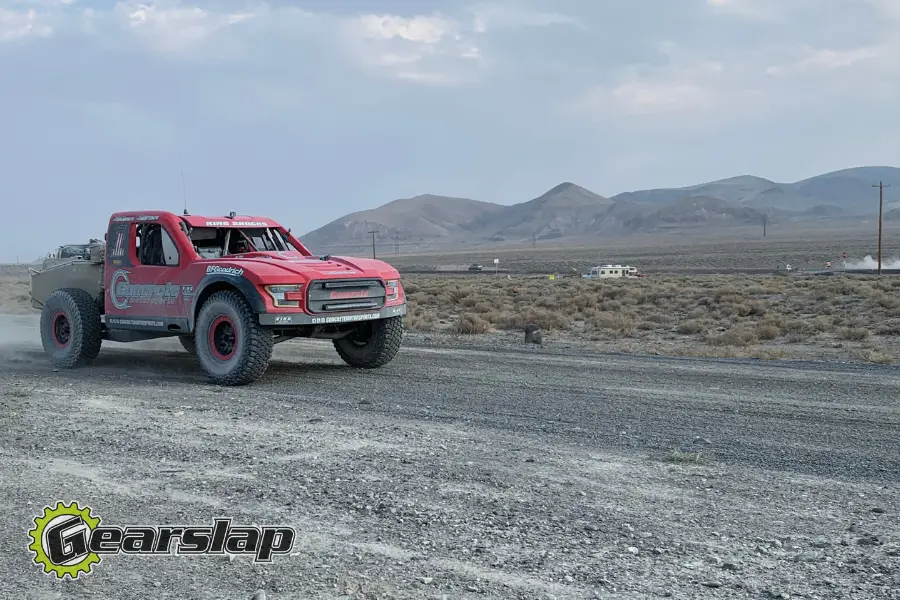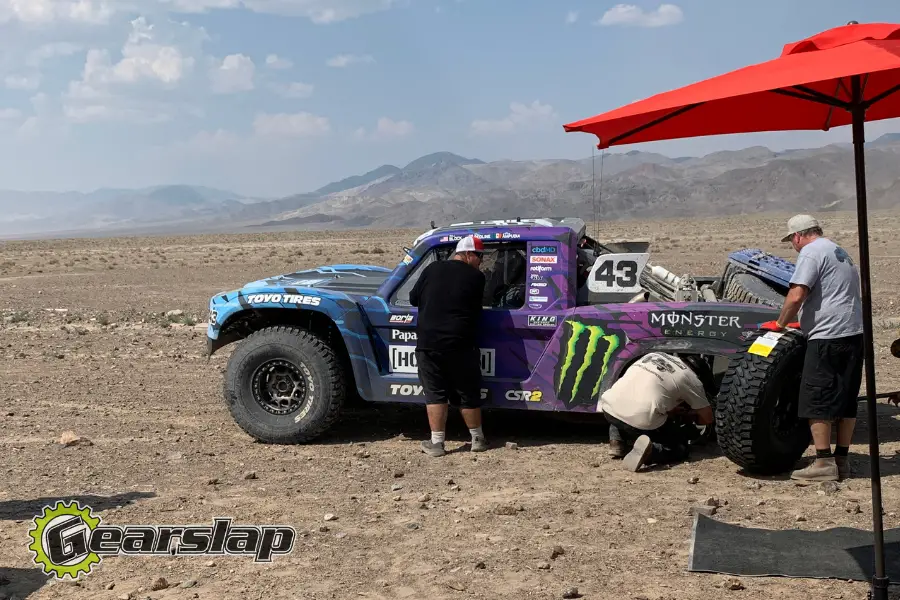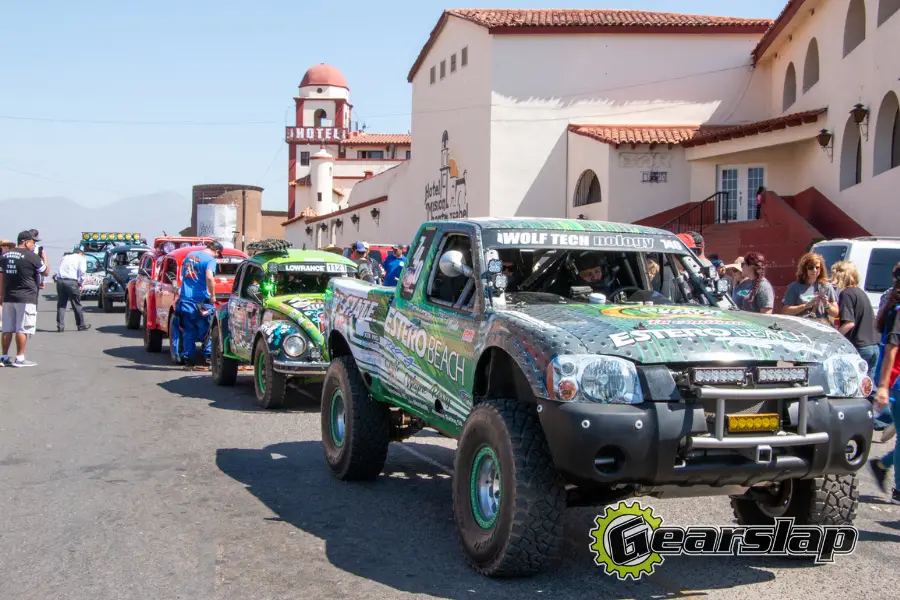For over 50 years, extreme race enthusiasts and adrenaline junkies have gathered in the Baja desert for the Baja 1000. From dust storms to flash floods, blind curves, and boobie traps, this race has earned the reputation of one of the deadliest and most challenging races on the planet.
Always familiar and never the same, the Baja 1000 has a storied history full of glory, trials, travails, and death. (You may have found this article because you’re interested in racing in the Baja 1000 someday – you’re in luck, we wrote a great article about who can enter SCORE International’s Baja race!)
I present for your edification some amazing Baja 1000 race facts.

1. What Is the Baja 1000?
The Baja 1000 is an off-road, multi-vehicle class race on Mexico’s starkly breathtaking Baja Peninsula. Every year various vehicle classes, including buggies, motorcycles, ATVs, and the infamous “Baja bug” class compete in the race.
Although each course is within the same geographical area, the course for the Baja 1000 varies from year to year. It is alternately a point-to-point race, from Ensenada to La Paz, or a loop race that starts and finishes in Ensenada.
2. Origins
The first officially timed run on the Baja peninsula happened in 1962. Honda was looking to hype its new CL72 motorcycle. They contacted motorcycle stuntman Bud Ekins to make an endurance run on their new machine.
After some thought, Ekins suggested they go down to Baja, Mexico, as the landscape was brutal and varied and practically unpopulated. At midnight in March 1962, Ekins lit out from Tijuana and finished in La Paz, 963 miles and just under 40 hours later.
Soon adventure seekers came to test their mettle against the Baja 1000 run, and the legend was born.
3. The First Official Baja 1000
In 1967, and originally called the “Mexican 1000”, the first official Baja 1000 race started in Tijuana and ended in La Paz. Started by Bud Ekins and Ed Pearlman, it consisted of 847 miles of terrain ranging from rocky desert to snowy mountain cliffs to blinding mesas of silt (I’ll get to that later).
The first vehicles to compete were motorcycles and dune buggies, including the “Baja Bug,” a lightly modified VW Beetle that today has a class of its own in the race. For some, the Baja Bug is the only way to truly experience the Baja 1000 race.
4. Longest Non-Stop Point-to-Point Race in the World
One of the most brutal aspects of the Baja 1000 race is that it is a non-stop push to the limits that Usually takes over 24 hours to complete. Drivers go through day and night without stopping, battling not only the unforgiving terrain but also exhaustion and mental strain.
Although other races lay claim as being longer than the Baja 1000 race, they are all multi-day stage races. No other race on the planet tests the limits of focus and endurance like the Baja 1000.
5. Deaths
Over the years, the Baja 1000 race has claimed dozens of lives. Some have been the racers
themselves, but more have been from spectators along the way.
An exact number of deaths isn’t known, but over four dozen have been documented. Among the more notable deadly moments:
- In 2013, pro motorcycle racer Kurt Caselli died when he hit an animal on the course.
- 2016 saw the deadliest single year recorded for the Baja 1000 with three deaths. Two of those were motorcycle racers, and the third was an eight-year-old boy who was struck by a competitor’s truck that lost control at a turn.
- In 1995, 23-year-old pro-cycle racer Danny Hamel died when he collided with a non-racing vehicle that found its way onto the course, which brings me to the next fun fact…
6. Roads Are Open During the Race
You might think, in the interest of safety for all, that the Baja 1000 race would be a closed course.
Not so. Although much of it is wide open, vast, and varied, the Baja 1000 racecourse does go through some towns and villages. Vehicles, pedestrians, and animals, both wild and domestic, regularly make their way onto the course, adding even more danger and chaos to this grueling challenge.
7. Celebrity Racers
The Baja 1000 attracts racers from all walks of life: pro racers, gearheads, adventure seekers, and, yes, celebrities, all make their way to the event.
Some of the notable participants over the years include:
James Garner raced in the first Baja 1000 races, which is part of what gave him entrance into the inaugural Off-Road Motorsports Hall of Fame.
Steve McQueen, the iconic actor, “King of Cool,” and race enthusiast, competed in the Baja 1000 as well as in its sister race, the Baja 500.
Chuck Norris competed one year with his brother Aaron. Of course Chuck Norris raced the Baja 1000.
Academy Award winner Paul Newman is not only arguably the most famous participant of all time, but, at 80 years old, was also the oldest racer ever to compete in the Baja 1000.
Rockers Ted Nugent and The Monkees Mike Nesmith also competed in different years.
Along with movie stars, many notable names from the lexicon of off-road racing have participated, including Malcolm Smith and Larry Roeseler.
8. Oldest Winner
Larry Roeseler also holds the record for the oldest person to win the Baja 1000, in 2020 at the age of 64.
9. Youngest winner
In 2006 Andy McMillin won the Baja 1000 with Robby Gordon. Andy was 19 at the time of his win.
10. Prize Money
The overall winner of the Baja 1000 wins $40,000. Individual class winners can take home anywhere from $600-$15,000.
11. Who’s Won the Most
Rod Hall holds the title for the most combined wins in the Baja 1000. Although he only holds one overall winner title, Hall competed in all of the first 50 Baja 1000 races and holds an incredible 25 trophies for in-class wins.
12. Fastest Finishing Time
The Baja 1000 doesn’t post a record for the all-time fastest time because the racecourse is different each year.
With that in mind, the winners of the Baja 1000 generally hold an average speed of about 51 MPH.
13. Longest Continuously Held Desert Race in the World
No other desert race has kept going, year after year, as consistently as the Baja 1000. Twenty twenty-two will be the 48th consecutive year running.
14. The Course Changes Every Year
Unlike most famous annual race events, the Baja 1000 race is different each year. In fact, the race alternately is run as a point-to-point race from Ensenada to La Paz on some years, and as a loop-race beginning and ending in Ensenada in other years.
The only consistency is that it is in the Baja Peninsula, and it will be brutal.
15. The Baja 1000 Isn’t Actually 1000
Speaking of course changes, part of the variation of each Baja 100 race is the length. It can range anywhere from 850 miles to over 1700 miles.
The reason for the name “Baja 1000” comes from the original run back in 1962 from Tijuana to La Paz, a distance of 963 miles.
16. Lost Racers
Another one of the 18 amazing Baja 1000 race facts is that every year, race teams fly off cliffs, get stuck in swamps, or disappear into clouts of silt (more on that to follow). The remote nature of the course leaves drivers stranded for hours or sometimes even days before they can be found and brought back from the edge of civilization.
17. The Silt
Twice now I’ve mentioned the silt. Fine as talcum powder, impossible to see coming, and ubiquitous in the Baja desert, silt is a force of nature unto itself, and the bane of Bajracers throughout.
Vehicles can literally get sucked into a silt drift and be stuck for hours. And when drivers hit it, the silt goes everywhere and reduces visibility to zero. It’s like having your own personal sandstorm over and over again while going 80MPH.

18. Booby Traps
Here’s a fun one: The locals build booby traps to cause fun-to-see accidents along the route. They will dig hidden trenches, make rock slides, and build pits to swallow trophy trucks. Because, you know, it’s all about the wipeouts.
19. Longest Finish Time
Officially, the Baja 1000 race stops accepting finishers after 50 hours, but that’s not to say that race teams don’t come limping in after that.
It’s a common refrain to hear new drivers being told, “don’t expect to finish your first time.” The Baja 1000 is so fraught with uncertainty and challenging chaos that finishing is more the exception than the rule.
That being said, every year a handful of drivers will come rolling through hours, or even a day or 2, after the last official finisher has crossed the line.
20. Getting Robbed at 100 MPH
As if unforgiving terrain, surprise herd animals on the track, booby traps, and inescapable pits of silt weren’t enough hazards, drivers also have to contend with bandits. False checkpoints, roadblocks, and other various tactics are used by bandits to collect bribes and fees for passage.
21. Helicopter Crash
Finally, the legend of the Baja 1000 race would not be complete without the story of the cartel kingpin who crashed his helicopter on the raceway.
In 2007, a helicopter said to have been flying with cartel kingpin Fransisco Merardo Leon Hinojosa, AKA El Abulón, crashed just about 60 miles outside of the starting point. Hinojosa died instantly, along with four others.
The story doesn’t end there. The next evening, a cadre of about a dozen black SUVs rolled up to the morgue, where a number of masked and armed men stormed the building, taking the body of El Abulón, along with two morgue staff members as hostages. The hostages were soon released unharmed. The body was never recovered.





